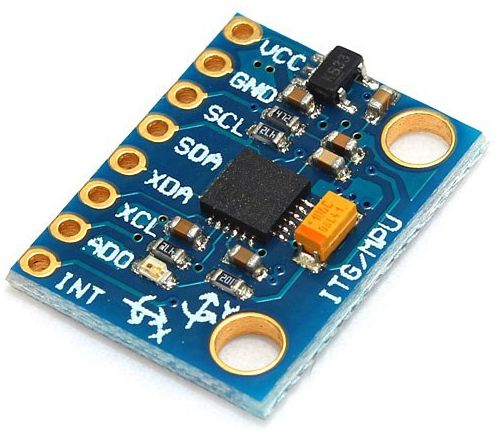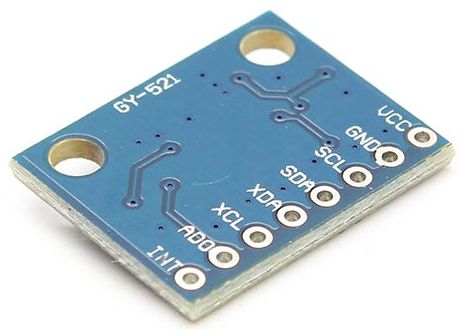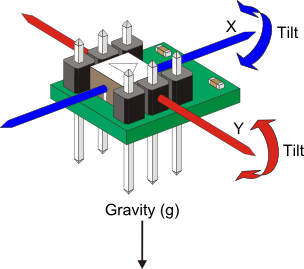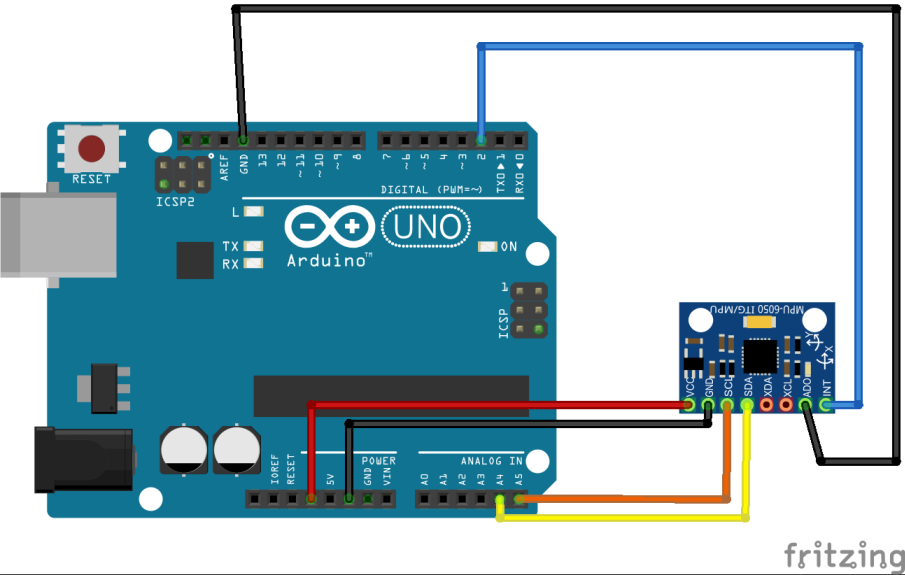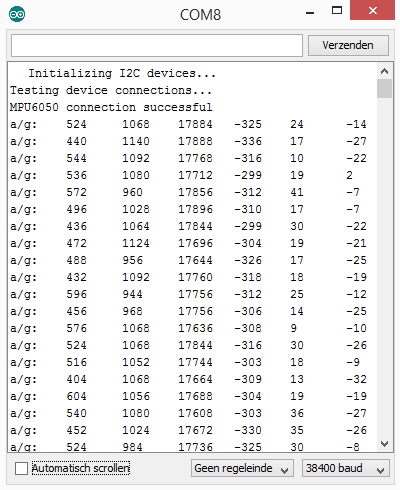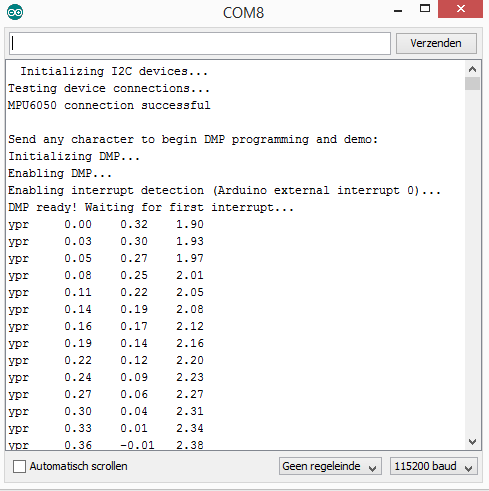Arduino – 6-Assige Gyroscoop + Versnellingsmeter MPU-6050 (GY-521)
Hardware
ITG/ MPU 6050 (GY-521) is een klein, laag vermogen, 3-assige gyroscoop en 3-assige versnellingsmeter met een hoge resolutie.
Voor het meten van: statische (tilt) en dynamische (bewegingen/schokken) versnelling en detectie van: tap, dubbel tap, vrije val en inactief, het wordt in veel apparaten toegepast, waaronder in mobiele telefoons en tablets (voor schermrotatie e.d.)
Pinout
 | |
|---|---|
| Pin: | Functie: |
| 1 | INT |
| 2 | ADO |
| 3 | XCL |
| 4 | XDA |
| 5 | SDA (serial data) |
| 6 | SCL (serial clock) |
| 7 | GND |
| 8 | VCC 3.3v+ |
Aansluiten op de Arduino
Sluit de Accelerometer module aan volgens onderstaand overzicht (zwart en blauw zijn NIET nodig):
| Arduino pin: | ITG/MPU 6050 (GY-521) pin: |
|---|---|
| 2 | INT |
| GND | ADO |
| A5 | SCL (serial clock) |
| A4 | SDA (serial data) |
| GND | GND |
| VCC 3.3v+ | VCC 3.3v+ |
Script “RAW”
Wat heb je nodig?
1) Arduino i2cdevlib bibliotheek
Sluit de MPU 6050 / GY521 module aan zoals hierboven aangegeven.
|
1 2 3 4 5 6 7 8 9 10 11 12 13 14 15 16 17 18 19 20 21 22 23 24 25 26 27 28 29 30 31 32 33 34 35 36 37 38 39 40 41 42 43 44 45 46 47 48 49 50 51 52 53 54 55 56 57 58 59 60 61 62 63 64 65 66 67 68 69 70 71 72 73 74 75 76 77 78 79 80 81 82 83 84 85 86 87 88 89 90 91 92 93 94 95 96 97 98 99 100 101 102 103 104 105 106 107 108 109 110 111 112 113 114 115 116 117 118 119 120 121 122 123 124 125 126 127 128 129 130 131 132 133 134 135 136 137 138 139 140 141 142 143 144 145 146 147 148 149 150 151 |
// I2C device class (I2Cdev) demonstration Arduino sketch for MPU6050 class // 10/7/2011 by Jeff Rowberg <jeff@rowberg.net> // Updates should (hopefully) always be available at https://github.com/jrowberg/i2cdevlib // // Changelog: // 2013-05-08 - added multiple output formats // - added seamless Fastwire support // 2011-10-07 - initial release /* ============================================ I2Cdev device library code is placed under the MIT license Copyright (c) 2011 Jeff Rowberg Permission is hereby granted, free of charge, to any person obtaining a copy of this software and associated documentation files (the "Software"), to deal in the Software without restriction, including without limitation the rights to use, copy, modify, merge, publish, distribute, sublicense, and/or sell copies of the Software, and to permit persons to whom the Software is furnished to do so, subject to the following conditions: The above copyright notice and this permission notice shall be included in all copies or substantial portions of the Software. THE SOFTWARE IS PROVIDED "AS IS", WITHOUT WARRANTY OF ANY KIND, EXPRESS OR IMPLIED, INCLUDING BUT NOT LIMITED TO THE WARRANTIES OF MERCHANTABILITY, FITNESS FOR A PARTICULAR PURPOSE AND NONINFRINGEMENT. IN NO EVENT SHALL THE AUTHORS OR COPYRIGHT HOLDERS BE LIABLE FOR ANY CLAIM, DAMAGES OR OTHER LIABILITY, WHETHER IN AN ACTION OF CONTRACT, TORT OR OTHERWISE, ARISING FROM, OUT OF OR IN CONNECTION WITH THE SOFTWARE OR THE USE OR OTHER DEALINGS IN THE SOFTWARE. =============================================== */ // I2Cdev and MPU6050 must be installed as libraries, or else the .cpp/.h files // for both classes must be in the include path of your project #include "I2Cdev.h" #include "MPU6050.h" // Arduino Wire library is required if I2Cdev I2CDEV_ARDUINO_WIRE implementation // is used in I2Cdev.h #if I2CDEV_IMPLEMENTATION == I2CDEV_ARDUINO_WIRE #include "Wire.h" #endif // class default I2C address is 0x68 // specific I2C addresses may be passed as a parameter here // AD0 low = 0x68 (default for InvenSense evaluation board) // AD0 high = 0x69 MPU6050 accelgyro; //MPU6050 accelgyro(0x69); // <-- use for AD0 high int16_t ax, ay, az; int16_t gx, gy, gz; // uncomment "OUTPUT_READABLE_ACCELGYRO" if you want to see a tab-separated // list of the accel X/Y/Z and then gyro X/Y/Z values in decimal. Easy to read, // not so easy to parse, and slow(er) over UART. #define OUTPUT_READABLE_ACCELGYRO // uncomment "OUTPUT_BINARY_ACCELGYRO" to send all 6 axes of data as 16-bit // binary, one right after the other. This is very fast (as fast as possible // without compression or data loss), and easy to parse, but impossible to read // for a human. //#define OUTPUT_BINARY_ACCELGYRO #define LED_PIN 13 bool blinkState = false; void setup() { // join I2C bus (I2Cdev library doesn't do this automatically) #if I2CDEV_IMPLEMENTATION == I2CDEV_ARDUINO_WIRE Wire.begin(); #elif I2CDEV_IMPLEMENTATION == I2CDEV_BUILTIN_FASTWIRE Fastwire::setup(400, true); #endif // initialize serial communication // (38400 chosen because it works as well at 8MHz as it does at 16MHz, but // it's really up to you depending on your project) Serial.begin(38400); // initialize device Serial.println("Initializing I2C devices..."); accelgyro.initialize(); // verify connection Serial.println("Testing device connections..."); Serial.println(accelgyro.testConnection() ? "MPU6050 connection successful" : "MPU6050 connection failed"); // use the code below to change accel/gyro offset values /* Serial.println("Updating internal sensor offsets..."); // -76 -2359 1688 0 0 0 Serial.print(accelgyro.getXAccelOffset()); Serial.print("\t"); // -76 Serial.print(accelgyro.getYAccelOffset()); Serial.print("\t"); // -2359 Serial.print(accelgyro.getZAccelOffset()); Serial.print("\t"); // 1688 Serial.print(accelgyro.getXGyroOffset()); Serial.print("\t"); // 0 Serial.print(accelgyro.getYGyroOffset()); Serial.print("\t"); // 0 Serial.print(accelgyro.getZGyroOffset()); Serial.print("\t"); // 0 Serial.print("\n"); accelgyro.setXGyroOffset(220); accelgyro.setYGyroOffset(76); accelgyro.setZGyroOffset(-85); Serial.print(accelgyro.getXAccelOffset()); Serial.print("\t"); // -76 Serial.print(accelgyro.getYAccelOffset()); Serial.print("\t"); // -2359 Serial.print(accelgyro.getZAccelOffset()); Serial.print("\t"); // 1688 Serial.print(accelgyro.getXGyroOffset()); Serial.print("\t"); // 0 Serial.print(accelgyro.getYGyroOffset()); Serial.print("\t"); // 0 Serial.print(accelgyro.getZGyroOffset()); Serial.print("\t"); // 0 Serial.print("\n"); */ // configure Arduino LED for pinMode(LED_PIN, OUTPUT); } void loop() { // read raw accel/gyro measurements from device accelgyro.getMotion6(&ax, &ay, &az, &gx, &gy, &gz); // these methods (and a few others) are also available //accelgyro.getAcceleration(&ax, &ay, &az); //accelgyro.getRotation(&gx, &gy, &gz); #ifdef OUTPUT_READABLE_ACCELGYRO // display tab-separated accel/gyro x/y/z values Serial.print("a/g:\t"); Serial.print(ax); Serial.print("\t"); Serial.print(ay); Serial.print("\t"); Serial.print(az); Serial.print("\t"); Serial.print(gx); Serial.print("\t"); Serial.print(gy); Serial.print("\t"); Serial.println(gz); #endif #ifdef OUTPUT_BINARY_ACCELGYRO Serial.write((uint8_t)(ax >> 8)); Serial.write((uint8_t)(ax & 0xFF)); Serial.write((uint8_t)(ay >> 8)); Serial.write((uint8_t)(ay & 0xFF)); Serial.write((uint8_t)(az >> 8)); Serial.write((uint8_t)(az & 0xFF)); Serial.write((uint8_t)(gx >> 8)); Serial.write((uint8_t)(gx & 0xFF)); Serial.write((uint8_t)(gy >> 8)); Serial.write((uint8_t)(gy & 0xFF)); Serial.write((uint8_t)(gz >> 8)); Serial.write((uint8_t)(gz & 0xFF)); #endif // blink LED to indicate activity blinkState = !blinkState; digitalWrite(LED_PIN, blinkState); } |


